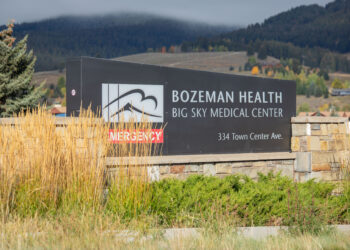Williams Academy fills a growing trade skills gap in Gallatin Valley
By Mira Brody VP Media
I can safely say I’ve never driven an articulated haul truck before, yet here I am, in the parking lot of Williams Academy trade school, inside a simulation training trailer, doing the closest thing to it. The machine is set up with virtual reality software, controls, sounds, obstacles and even motion—my seat jostles as I navigate my truck through uneven terrain. They’re all elements identical to what is common on a job site behind the wheel of a massive piece of construction equipment. I learn quickly that operating heavy machinery takes a lot of finesse and muscle memory.

“Nothing completely replaces being in the machine, but [this] just really enhances the safety of stepping into the machine for the first time,” Chark Young, heavy equipment operator trainer at Williams Academy tells me. “You’re really going to cut down on … equipment damage too.”
The Williams Academy Trailer is one of the many unique investments of Williams Plumbing and Heating’s Williams Academy, an accredited trade school intended to properly equip tradespeople with high-quality education and training in skilled trades related to plumbing, heating and civil engineering. It’s not only an education system however; it also serves as an often overlooked opportunity, and community for many who walk through its doors.
“I can’t stress this enough: community is huge, passion is huge,” said Mark Watkins, director of business sales. “And the more time you spend with your employees, your colleagues, your staff, your team, it just creates that whole atmosphere of success. And that’s what we’re building here.
“It’s not just a job; it’s an investment in our employees.”

Williams Academy took on its first students in June 2024. The company realized that investing in the next generation of trade skills would benefit not only them as a business, keeping up with demand in the region they serve, but also the economy as a whole, as the current trade workforce approaches retirement. They’ve invested in the creation of their own workforce, while also providing a critical skillset, and the opportunity for a solid career, with a livable salary and upward mobility.
“In the next four to five years, up to 40% of the current trades workforce is going to retire,” Marketing Coordinator Steve Olp explained. “We have essentially a missing generation of trade people. So that’s what we’re trying to catch up with right now.”
The academy’s current enrollment consists of 75 plumbing apprentices, six HVAC apprentices and two heavy equipment apprentices. While all are employees of Williams, the academy’s long-term vision is to build the infrastructure for a full time, full service trade school to serve anyone interested. Right now, their primary academy campus in Belgrade is supplemented by 10 teachers, with a plan to bring on four more this fall, as well as a satellite school in Missoula. They are the only trade school in the state accredited by the National Center for Construction Education and Research.
“We’re doing this early,” Olp said. “We’re trying to be at the cutting edge for the state of Montana, and the area where somebody can come out of high school or come out of the military … you can start your career, have training, do it in four years, graduate with no debt, and make up to $44 an hour.”
HVAC and plumbing apprenticeship programs are four-year commitments, with eight course books and 7,500-8,000 training hours, which take place on a live job site, explained Amanda Mills, learning and development manager. The heavy equipment operation apprenticeship is a two-year program, including four course books and 3,500 training hours. Upon completion, students receive a certificate that allows them to test with the state of Montana for their journeyman plumber license. Career opportunities range from heavy equipment operation, to engineering, marketing, management and even specialty skills, such as medical gas systems in hospitals and dentist offices.
”We’re not opposed to college, obviously, a lot of people that work in this company went to college,” Watkins said. “But the reality is today, you don’t have to, you can come in and we can put you to work right away and you can be earning revenue. And that is significant.”

A core value of Williams Academy is the nontraditional, hands-on approach, apparent not only during my experience in the simulation trailer, but also upon walking into the primary training building where a variety of pseudo display toilets, sinks, electrical circuits and other such practice sites are on display. Here, students learn how to problem solve alongside their more seasoned peers.
“We’ve been trying to figure out not just how can we do it a little bit better than anybody else, but how can we be the only organization that is taking the entire vertically integrated process,” said Josh Montayne, Williams’ executive vice president. “The end goal, like Steve said, is a vocational school that any competitor, whoever, can come send their employees to a lab to learn. I mean, it makes the whole market better.”
As Watkins emphasized earlier, the campus serves as a community space, inviting middle and high school students to observe, and yes, operate the simulator, for manufacturing school day; OSHA and other local general contractors have utilized their training facility; Montana State Prison in Deer Lodge aims to build a facility modeled off of Williams’ to aid with their inmate pre-release program; and they’ve even hosted local blood drives.
While trade-driven, it’s apparent that at the forefront of the skills they’re building, are the people doing them.
“Success is contagious,” Olp said, describing “signing day,” in which a new apprentice signs on with Williams Academy, and where family is often invited to celebrate the milestone.
“As a leadership team, we talk about, how do we have a culture where people go home for Thanksgiving and someone says, ‘How’s your job?’ And they get the chills because they’re so excited to talk about it,” Montayne said. “So how do we create an environment where that’s what it is?”














